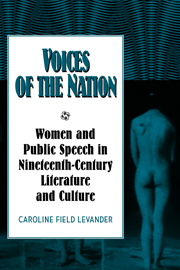Book contents
- Frontmatter
- Contents
- Acknowledgments
- Introduction: Gender, Speech, and Nineteenth-Century American Life
- 1 Bawdy Talk: The Politics of Women's Public Speech in Henry James's The Bostonians and Sarah J. Hale's The Lecturess
- 2 “Foul-Mouthed Women”: Disembodiment and Public Discourse in Herman Melville's Pierre and E. D. E. N. Southworth's The Fatal Marriage
- 3 Incarnate Words: Nativism, Nationalism, and the Female Body in Maria Monk's Awful Disclosures
- 4 Southern Oratory and the Slavery Debate in Caroline Lee Hentz's The Planter's Northern Bride and Harriet Jacobs's Incidents in the Life of a Slave Girl
- 5 Partners in Speech: Reforming Labor, Class, and the Working Woman's Body in Elizabeth Stuart Phelps's The Silent Partner
- 6 “Queer Trimmings”: Dressing, Cross-dressing, and Woman's Suffrage in Lillie Devereux Blake's Fettered for Life
- Conclusion: Women and Political Activism at the Turn into the Twentieth Century
- Notes
- Select Bibliography
- Index
- CAMBRIDGE STUDIES IN AMERICAN LITERATURE AND CULTURE
Conclusion: Women and Political Activism at the Turn into the Twentieth Century
Published online by Cambridge University Press: 27 October 2009
- Frontmatter
- Contents
- Acknowledgments
- Introduction: Gender, Speech, and Nineteenth-Century American Life
- 1 Bawdy Talk: The Politics of Women's Public Speech in Henry James's The Bostonians and Sarah J. Hale's The Lecturess
- 2 “Foul-Mouthed Women”: Disembodiment and Public Discourse in Herman Melville's Pierre and E. D. E. N. Southworth's The Fatal Marriage
- 3 Incarnate Words: Nativism, Nationalism, and the Female Body in Maria Monk's Awful Disclosures
- 4 Southern Oratory and the Slavery Debate in Caroline Lee Hentz's The Planter's Northern Bride and Harriet Jacobs's Incidents in the Life of a Slave Girl
- 5 Partners in Speech: Reforming Labor, Class, and the Working Woman's Body in Elizabeth Stuart Phelps's The Silent Partner
- 6 “Queer Trimmings”: Dressing, Cross-dressing, and Woman's Suffrage in Lillie Devereux Blake's Fettered for Life
- Conclusion: Women and Political Activism at the Turn into the Twentieth Century
- Notes
- Select Bibliography
- Index
- CAMBRIDGE STUDIES IN AMERICAN LITERATURE AND CULTURE
Summary
Fifty years after Constance Fenimore Woolson published “The Lady of Little Fishing” in one of the short story collections upon which literary critic Fred Lewis Pattee bases his assessment of her work, he declared that, “during the ‘seventies,” Woolson “undoubtedly … was the most ‘unconventional’ feminine writer that had yet appeared in America.” No doubt because of the unconventionality that, among other things, distinguished Woolson's writing, Henry James considered his friend and correspondent to be “a very intelligent woman” and “gifted authoress” and claimed that, other than William Dean Howells, Woolson was the only English-language novelist he read. However, James was not the only one to voice his opinions. Woolson, in an 1882 letter to James, admits to being confounded by his choice of subject matter in The Portrait of a Lady. “How did you ever dare write a portrait of a lady?” she wonders. “Fancy any woman's attempting a portrait of a gentleman! … [I]n my small writings, I never dare put down what men are thinking, but confine myself simply to what they do and say” (535). However, what men do and say, as Woolson depicts both in “The Lady of Little Fishing,” reveal how their private as well as their public lives depend upon the woman public speaker who enters their community. Written at the end of the era I consider, the short story that many scholars consider to be Woolson's best highlights my project's main premises, showing, first, how discourses about American women's voices and their relation to public speech shape and order a culture in radical transition, second, how women's speech undermines the social change in which it is implicated, and, third, how women writers employ this politically revisionist speech in their fiction in order to contribute to the politics of the public arena.
- Type
- Chapter
- Information
- Voices of the NationWomen and Public Speech in Nineteenth-Century American Literature and Culture, pp. 141 - 146Publisher: Cambridge University PressPrint publication year: 1998



